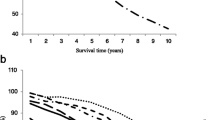Abstract
Purpose
Due to prolonged survival, there will be many more chronic myeloid leukemia (CML) patients alive in the future. The aims of this work were to estimate the current prevalence of CML by using routine data and to project future patient numbers in Germany.
Methods
Data were available for about 10.5 million people in the statutory health insurance system in Bavaria for the years 2008–2013. Survival rates were adapted from two recent publications.
Results
The mean estimated age-standardized (Old European Standard Population) incidence rates per 100,000 inhabitants were 1.300 and 1.768 for women and men. Based on the population data, we estimated a total number of about 9000 CML patients in Germany for 2012. We expect the number of CML patients to increase further until at least 2040–2050 with a maximum of more than 20,000 CML patients as the most probable scenario.
Conclusions
Using a restrictive definition for case patients, we do not think that there is much overestimation. As a consequence of this considerable increase of the prevalence of CML the burden for the health care system will increase with respect to costs and medical care needed. The procedure presented here allows to estimate the expected number of CML patients in other countries, too.



Similar content being viewed by others
Explore related subjects
Discover the latest articles and news from researchers in related subjects, suggested using machine learning.References
Bjorkholm M et al (2011) Success story of targeted therapy in chronic myeloid leukemia: a population-based study of patients diagnosed in Sweden from 1973 to 2008. J Clin Oncol 29:2514–2520. doi:10.1200/jco.2011.34.7146
Blakely T, Barendregt JJ, Foster RH, Hill S, Atkinson J, Sarfati D, Edwards R (2013) The association of active smoking with multiple cancers: national census-cancer registry cohorts with quantitative bias analysis. Cancer Causes Control 24:1243–1255. doi:10.1007/s10552-013-0204-2
Brenner H, Gondos A, Pulte D (2008) Recent trends in long-term survival of patients with chronic myelocytic leukemia: disclosing the impact of advances in therapy on the population level. Haematologica 93:1544–1549. doi:10.3324/haematol.13045
Cogle CR et al (2014) High rate of uncaptured myelodysplastic syndrome cases and an improved method of case ascertainment. Leuk Res 38:71–75. doi:10.1016/j.leukres.2013.10.023
Gratwohl A, Baldomero H, Passweg J (2015) The role of hematopoietic stem cell transplantation in chronic myeloid leukemia. Ann Hematol 94(Suppl 2):S177–S186. doi:10.1007/s00277-015-2313-3
Hehlmann R (2015) CML—where do we stand in 2015? Ann Hematol 94(Suppl 2):S103–S105. doi:10.1007/s00277-015-2331-1
Hoffmann VS et al (2015) The EUTOS population-based registry: incidence and clinical characteristics of 2904 CML patients in 20 European Countries. Leukemia 29:1336–1343. doi:10.1038/leu.2015.73
Hoglund M et al (2013) Tyrosine kinase inhibitor usage, treatment outcome, and prognostic scores in CML: report from the population-based Swedish CML registry. Blood 122:1284–1292. doi:10.1182/blood-2013-04-495598
Hoglund M, Sandin F, Simonsson B (2015) Epidemiology of chronic myeloid leukaemia: an update. Ann Hematol 94(Suppl 2):S241–S247. doi:10.1007/s00277-015-2314-2
Huang X, Cortes J, Kantarjian H (2012) Estimations of the increasing prevalence and plateau prevalence of chronic myeloid leukemia in the era of tyrosine kinase inhibitor therapy. Cancer 118:3123–3127. doi:10.1002/cncr.26679
Kabat GC, Wu JW, Moore SC, Morton LM, Park Y, Hollenbeck AR, Rohan TE (2013) Lifestyle and dietary factors in relation to risk of chronic myeloid leukemia in the NIH-AARP Diet and Health Study. Cancer Epidemiol Biomarkers Prev 22:848–854. doi:10.1158/1055-9965.epi-13-0093
Kantarjian H et al (2012) Improved survival in chronic myeloid leukemia since the introduction of imatinib therapy: a single-institution historical experience. Blood 119:1981–1987. doi:10.1182/blood-2011-08-358135
Mahon FX et al (2010) Discontinuation of imatinib in patients with chronic myeloid leukaemia who have maintained complete molecular remission for at least 2 years: the prospective, multicentre Stop Imatinib (STIM) trial. Lancet Oncol 11:1029–1035. doi:10.1016/s1470-2045(10)70233-3
McQuilten ZK et al (2014) Underestimation of myelodysplastic syndrome incidence by cancer registries: results from a population-based data linkage study. Cancer 120:1686–1694. doi:10.1002/cncr.28641
Nennecke A, Wienecke A, Kraywinkel K (2014) Leukemia incidence and survival in Germany according to current standardized categories. Bundesgesundheitsblatt Gesundheitsforschung Gesundheitsschutz 57:93–102. doi:10.1007/s00103-013-1869-0
Ohm L et al (2014) Real-world cost-effectiveness in chronic myeloid leukemia: the price of success during four decades of development from non-targeted treatment to imatinib. Leuk Lymphoma. doi:10.3109/10428194.2014.953141
Pötzsch O, Rößger F (2015) Bevölkerung Deutschlands bis 2060. 13. koordinierte Bevölkerungsvorausberechnung. Statistisches Bundesamt, Weisbaden
Pulte D et al (2013) Population level survival of patients with chronic myelocytic leukemia in Germany compared to the US in the early 21st century. J Hematol Oncol 6:70. doi:10.1186/1756-8722-6-70
Pulte D, Redaniel MT, Bird J, Jeffreys M (2015) Survival for patients with chronic leukemias in the US and Britain: age-related disparities and changes in the early 21st century. Eur J Haematol 94:540–545. doi:10.1111/ejh.12468
Smith AG et al (2014) Determinants of survival in patients with chronic myeloid leukaemia treated in the new era of oral therapy: findings from a UK population-based patient cohort. BMJ Open 4:e004266. doi:10.1136/bmjopen-2013-004266
Storey S (2009) Chronic myelogenous leukaemia market. Nat Rev Drug Discov 8:447. doi:10.1038/nrd2908
Acknowledgments
We would like to thank Carina Fink, Christina Niedermeier, Annett Schmitt and Andrea Stüven for their valuable help.
Author contributions
ML designed the research, checked, analyzed and interpreted the data, and wrote the first draft of the manuscript. RG provided, processed, and interpreted the data. MT provided, processed, and interpreted the data. JH analyzed and interpreted the data and designed the research. All authors contributed to the manuscript and approved the final version.
Author information
Authors and Affiliations
Corresponding author
Ethics declarations
Conflict of interest
Michael Lauseker, Roman Gerlach, Martin Tauscher, and Joerg Hasford declare that they have no conflict of interest.
Ethical approval
This article does not contain any studies with human participants or animals performed by any of the authors.
Electronic supplementary material
Below is the link to the electronic supplementary material.
Rights and permissions
About this article
Cite this article
Lauseker, M., Gerlach, R., Tauscher, M. et al. Improved survival boosts the prevalence of chronic myeloid leukemia: predictions from a population-based study. J Cancer Res Clin Oncol 142, 1441–1447 (2016). https://doi.org/10.1007/s00432-016-2155-y
Received:
Accepted:
Published:
Issue Date:
DOI: https://doi.org/10.1007/s00432-016-2155-y




